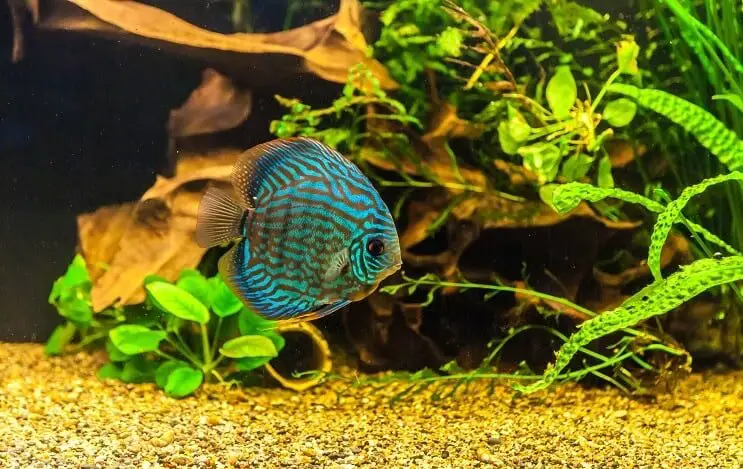
In captivity they prefer stable environments, the tank conditions will have to be maintained and stable.ĭiscus fish prefer higher water temperatures than a lot of fish. Because of this, they are considered a specialty breed. A group of 5 can live comfortably in a 55-gallon tank.ĭiscus fish are harder to keep as they have a very specific diet and tank needs. They are schooling fish and need to be in groups of their own kind. It is a general rule that there should be 10 gallons for every discus fish. Examples of tank mates to avoid are:ĭiscus grow quite large and because of that they need a bigger space. Tank mates that are aggressive, fast-moving, and larger should be avoided as they will stress the discus. This can cause them to not get enough food which will result in a lack of nutrients. As discus are slower moving and will take longer to reach the food. It is best to avoid faster fish that will create competition for food. Tank mates should also be large enough to not be a meal for the discus, best to avoid nano fish.Įxamples of ideal tank mates for discus fish: Tank mates for discus should be slow-moving, non-aggressive, and require similar tank conditions. They do well with other peaceful tank mates.

If you plan to add tank mates, ensure you have a large enough tank.ĭiscus prefer a few tank mates outside their group rather than large groups of other species.ĭiscus are peaceful and make great tank mates. Keep in mind they are schooling fish and need to be kept in groups of their own kind of at least 6. Ideal Discus Tank MatesĪs previously stated, discus are peaceful but intimidated by poor tank mates. It is recommended to feed adult discus fish, one year and older, 2 or 3 times per day. This rule states to feed them approximately 3% of their body weight each feeding. To avoid this there is a general rule when feeding discus fish. It is very important to not overfeed your discus. Some foods such as shrimp eggs are considered pigment-enhancing foods and will help the discus develop more vibrant colors.īecause of the flat shape of their bodies, they eat smaller meals throughout the day.Īlso, discus fish have quite small mouths and can sometimes have difficulty eating some foods if they are too large. Live food such as bloodworms, brine shrimp, blackworms, and microworms are great options. They will also need to be fed live or frozen foods as a source of protein. It is important to have a well-balanced diet for them to thrive.Īlso, the variety in food will provide a variety of options as they can be picky eats.Ī high-quality flake or pellet is a great foundation for their diet. Diet and Feedingĭiscus fish are omnivores and in the wild, they will eat insects, plankton, and invertebrates.Īs with any other species, it is best to mimic this diet in captivity. Due to this, they should be kept with fish that are similar in size as well as similar speeds. They are part of the cichlid family and because of this, they can be territorial. Discus fish are active during the day and will sleep at night. This is because they thrive when they are able to move slowly in their group around the tank. Temperament and Behaviorĭiscus fish are very peaceful, often shy, fish that are intimidated by aggressive, larger, and faster fish. In the wild their lifespans are much shorter due to predators.

The male discus is slightly larger than the female discus.Īlso in captivity, they can live for an average of 10 to 15 years. In captivity the discus fish can grow up to 9 inches long! In the wild, they will typically only grow to 4.8 to 6 inches in length. There are also different variations of colors and patterns due to breeding that can be found. A brown discus has nine vertical stripes over their bodies.ĭiscus fish have flat rounded bodies that are similar to an angelfish without fins. One of those stripes runs through their eye.īlue and green discus have red dots instead of vertical stripes. Typically heckle discus are pale yellow and have three vertical stripes of that color.
#DISCUS FISH TANK MATES FULL#
Their full color emerges as they mature and will change color according to their environment. This is because of hybridization from captivity breeding. Discus fish that are in captivity are typically brighter than those in the wild. Appearance and Temperament Appearanceĭiscus fish have four main colors as well as a variety of patterns and markings. They can range between 4.6 to 8 inches so they need a large enough tank to accommodate this. For the most part, they are peaceful fish that love to be in a community amongst themselves or just of their own kind. tarzoo (green discus)ĭiscus fish, Pompadour fish, King of the aquariumġ0 gallons for oneMore than 60 gallons for a group of 6ĭiscus fish are a category of freshwater fish that come in a variety of colors. Symphysodon aequifasciatus (Blue or brown)S.


 0 kommentar(er)
0 kommentar(er)
